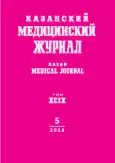To the issue of the use of sodium-lithium countertransport rate in red cell membrane as a prognostic marker of artherial hypertension mordbidity and mortality: an experience of 25-year follow up cohort study
- Authors: Makarov MA1, Oslopov VN1, Ganeeva KI2
-
Affiliations:
- Kazan State Medical University
- City hospital No 11
- Issue: Vol 99, No 5 (2018)
- Pages: 839-846
- Section: Clinical experiences
- URL: https://journals.rcsi.science/kazanmedj/article/view/10312
- DOI: https://doi.org/10.17816/KMJ2018-839
- ID: 10312
Cite item
Full Text
Abstract
Aim. The article discusses the results of a long-term cohort study devoted to the search for the possible relationship of arterial hypertension morbidity and mortality with the rate of sodium-lithium countertransport (Na+-Li+-СT) in red cell membrane which is a marker of the structural and functional state of the cell membrane.
Methods. The study of the functional state of cell membranes by determining the maximal rate of Na+-Li+-CT in red cell membrane with quintiles analysis of the rate of Na+-Li+-CT. Screening clinical examination, including registration of blood pressure (BP), ECG study, the study of eyeground vessels, one- and two-dimensional echocardiography (EchoCG), the study of the lipid spectrum of the blood. Analysis of medical records.
Results. Based on the results of long-term follow up of the aging cohort total mortality is not associated with Na+-Li+-СT rate in red cell membrane. At the average age of 50 bimodality is detected in the development of new cases of primary arterial hypertension associated with the values of Na+-Li+-СT rate of the 1st quartile (36-206 micromoles of Li per liter of cells per hour) and 3d quartile (276-347 micromoles of Li per liter of cells per hour). At the average age of cohort of 55.6±6.7 years the distribution of patients with arterial hypertension by quartiles of Na+-Li+-СT rate becomes almost identical with the statistically non-significant prevalence of 4th quartile of Na+-Li+-СT rate.
Conclusion. The expected correlation between mortality among persons with hypertension and membrane disorders determined by the high rate of Na+-Li+-СT was not revealed. However, the tendency to the predominance of mortality at high Na+-Li+-СT rate suggests that with a much larger sample size a significant relationship may be confirmed. The necessity of studying the relationship between mortality from arterial hypertension and high rate of Na+-Li+-СT in female cohorts remains actual. Increasing difference of mortality rate among patients with and without arterial hypertension with high rate of Na+-Li+-СT can indicate the relationship between mortality from arterial hypertension and membrane disorders.
Full Text
##article.viewOnOriginalSite##About the authors
M A Makarov
Kazan State Medical University
Author for correspondence.
Email: maks.vfrfhjd2011@yandex.ru
Kazan, Russia
V N Oslopov
Kazan State Medical University
Email: maks.vfrfhjd2011@yandex.ru
Kazan, Russia
K I Ganeeva
City hospital No 11
Email: maks.vfrfhjd2011@yandex.ru
Kazan, Russia
References
- Fletcher R., Fletcher S., Vagner E. Klinicheskaya epidemiologiya. Osnovy dokazatel’noy meditsiny. Moscow: Media Sfera. 1998; 352 p. (In Russ.)
- Oganov R.G. Osnovy dokazatel’noy meditsiny v kardiologii. (The basics of evidence-based medicine in cardiology. Guide for cardiology.) Ed by G.I. Storozhakov and A.A. Gorbachenkov. GEOTAR-Media. 2008; 15–29. (In Russ.)
- Постнов Ю.В., Орлов С.Н. Первичная гипертензия как патология клеточных мембран. М.: 1987; 192 с. [Postnov Yu.V., Orlov S.N. Pervichnaya gipertenziya kak patologiya kletochnykh membran. (Primary hypertension as pathology of cell membranes.) Moscow. 1987; 192 p.
- (In Russ.)]
- Postnov Yu.V. About a new stage in the development of the membrane concept of pathogenesis of essential hypertension: the role of cell oncogenes in the cell membrane disorders genesis. Arkhiv patologii. 1989; (11): 5–12. (In Russ.)
- Canessa M.L. Kinetic properties of Na/H and Na/Li exchanges of human red cells. Methods Enzymol. 1989; 173: 176–191. doi: 10.1016/S0076-6879(89)73012-3.
- Britov A.N., Kobal A.M., Orlov S.N. et al. The rate of Na+/Li+ countertransport of erythrocytes and arterial hypertension: data from a sectional population study. Kardiologiya. 1991; 31 (8): 54–58. (In Russ.)
- Britov A.N., Kobal A.M., Orlov S.N. et al. The value of Na+/Li+ countertransport in erythrocytes as a risk factor for essential hypertension (prospective study data). Kardiologiya. 1991; (1): 49–51. (In Russ.)
- Hasstedt S.J., Wu L.L., Ash K.O. et al. Hypertension and sodium-lithium countertransport in Utah pedigrees: evidence of major locus inheritance. Am. J. Human Genet. 1988; 43: 14–22. PMID: 3163887.
- Laurenzi M., Cirillo M., Panarelli W. et al. Baseline sodium-lithium countertransport and 6-year incidence of hypertension: the Gubbio population study. Circulation. 1997; (95): 581–587. doi: 10.1161/01.CIR.95.3.581.
- Hunt S.C., Stephenson S.H., Hopkins P.N. et al. Predictors of an increased risk of future hypertension in Utah. Hypertension. 1991; 17: 969–976. DOI: 10.1161/
- HYP.17.6.969.
- Rebbeck T.R., Turner S.T., Michels W. et al. Genetic and environmental explanations for the distribution of sodium-lithium countertransport in pedigrees from Rochester, MN. Am. J. Human Genet. 1991; 48: 1092–1104. PMID: 2035530.
- Oslopov V.N. Arterial’naya gipertenziya i kletochnaya membrana. (Arterial hypertension and cell membrane. Monography.) Kazan: «MeDDok». 2014; 644 p. (In Russ.)
- Leonova M.V. A modern view of the endpoints for the evaluation of antihypertensive therapy. Kachestvennaya klinicheskaya praktika. 2002; (4): 18–22. (In Russ.)
- Hansson L. Evaluation of endpoints in hypertension. Blood Press Suppl. 1997; 2: 76–80. PMID: 9495632.
- Man A.J., Veld T. Surrogate end points in clinical trials. Blood Press. 1997; (6 suppl. 2): 120–123.
- Oslopov V.N., Makarov M.A. The results of long-term follow-up of the dynamics of the incidence of primary arterial hypertension in the male cohort depending on the functional state of the cell membranes. Prakticheskaya meditsina. 2011; (4): 49–52. (In Russ.)
- Makarov M.A., Oslopov V.N. Interrelation of mortality among males with the structural and functional state of cell membranes. Kazan medical journal. 2010; 91 (6): 750–754. (In Russ.)
Supplementary files






